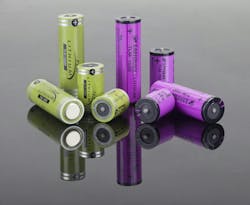Advanced Lithium Batteries Can Power Devices for Decades
The IIoT (Industrial Internet of Things) concept is rapidly expanding into remote sites and extreme environments that require intelligent battery-powered solutions. These applications include asset tracking, supervisory control and data acquisition (SCADA), environmental monitoring, machine-to-machine communications, artificial intelligence/machine learning and more.
Most remote wireless devices are powered by primary (non-rechargeable) lithium batteries, operating primarily in a stand-by state, drawing average current measurable in micro-amps, alternating with multi-amp pulses to power wireless communications.
As the lightest non-gaseous metal, lithium delivers the highest intrinsic negative potential, highest specific energy (energy per unit weight) and highest energy density (energy per unit volume) of any battery chemistry. Lithium batteries feature an operating current voltage ranging from 2.7 to 3.6V. They are also non-aqueous, thus less susceptible to freezing.
Among primary lithium chemistries, bobbin-type lithium thionyl chloride (LiSOCl2) is overwhelmingly preferred for remote deployments due to its extended temperature range, high capacity, high energy density and extremely low annual self-discharge rate.
Minimizing self-discharge
Numerous factors need to be considered when specifying an ultra-long-life battery. These parameters include the amount of current consumed during active mode, including the size, duration and frequency of pulses; the amount of current consumed during ‘stand-by’ mode (i.e., the base current); storage time—where self-discharge diminishes cell capacity; thermal environments (during storage and operation); and cut-off voltage, which drops as cell capacity is exhausted or from prolonged exposure to extreme temperatures.
Perhaps of greatest importance is the cell’s annual self-discharge rate, which often exceeds the amount of energy consumed while operating the device. Self-discharge results from the chemical reactions that occur even when a cell is not in use or is disconnected. Self-discharge can be significantly reduced by harnessing the passivation effect.
Unique to LiSOCl2 chemistry, passivation occurs when a thin film of lithium chloride (LiCl) forms on the surface of the anode to separate it from the electrode, thereby reducing the chemical reactions that cause self-discharge. Whenever a continuous load is applied, the passivation layer causes initial high resistance and a temporary drop in voltage until the layer of LiCl begins to dissipate, which is a continually repeating process. How a cell is manufactured, and the quality of the raw materials, can significantly impact the passivation effect and thus self-discharge. Superior quality bobbin-type LiSOCl2 cells can feature a self-discharge rate as low as 0.7% per year, meaning they are able to retain 70% of their original capacity after 40 years. By contrast, inferior quality LiSOCl2 cells can lose up to 3% of their capacity each year due to self-discharge, exhausting 30% of their total energy every 10 years, making a 40-year battery life unachievable.
Powering two-way wireless communications
Bobbin-type LiSOCl2 cells are designed to deliver low-rate current, so they must be paired with a patented hybrid layer capacitor (HLC) to generate high pulses. Using this hybrid approach, the bobbin-type LiSOCl2 cell delivers low-level base current during standby mode while the HLC generates periodic pulses of up to 15A during active mode. The HLC also features a unique end-of-life voltage plateau that can be interpreted to deliver low battery status alerts.
Supercapacitors perform a similar function in consumer electronics but have serious limitations for industrial applications, including short-duration power, linear discharge qualities that do not permit full discharge of available energy, low capacity, low energy density and a very high self-discharge rate of up to 60% per year. Supercapacitors linked in series also require cell-balancing circuits that are bulky, expensive and draw additional current to further shorten their operating life.
Lower your total cost of ownership
Ultra-long-life batteries can achieve long-term savings by reducing or eliminating the need for battery replacement to lower the cost of ownership. Unfortunately, higher quality cells can be hard to distinguish because short-term tests and theoretical models tend to underestimate the effects of passivation as well as prolonged exposure to extreme temperatures.
When extended battery life is essential, due diligence is required to carefully evaluate products. Making an informed choice requires access to verifiable test results along with in-field performance data from comparable devices operating under similar loads and environmental conditions.
Dr. Vitaly Milner, Ph.D, is product manager at Tadiran Batteries
About the Author

Leaders relevant to this article:

